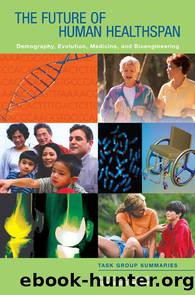THE FUTURE OF HUMAN HEALTHSPAN: Demography, Evolution, Medicine, and Bioengineering by The National Academies

Author:The National Academies
Language: eng
Format: epub
Tags: Health and Medicine : Aging
Publisher: NATIONAL ACADEMY PRESS
Published: 2008-05-08T00:00:00+00:00
Day 2: Restructuring Work and Leisure
On the second day the group returned to an issue they had touched on during the first day: work and retirement.
âWe know the modal age of retirement was 62, which is starting to creep up.â said Eileen Crimmins, who is a professor of gerontology at the Davis School of Gerontology at the University of Southern California and director of the USC/UCLA Center on Biodemography and Population Health. âPeople want to retire at some point,â she said, âbut they like the idea of having jobs and flextime. We know what people want to do and we kind of know what people have to do.â
What people have to do, the group agreed, is continue working later in life. That might mean later retirement or second careers or part-time work while in retirement. To encourage continued work older adults would need more options, including the chance for midcareer retraining and the opportunity to have different types of intellectually or socially meaningful part-time jobs as a second career.
Opportunities like working with Experience Corps, a program funded by AmeriCorps that trains older adults to act as tutors for struggling city-school students, might provide the type of opportunity that could keep the elderly socially and intellectually engaged while they earn a small stipend. But Experience Corps, like other programs, hasnât been evaluated for the health impact it has on the adults who tutor.
In addition to a lack of appealing job options, transportation can be a major barrier to continued work, particularly in the case of older adults who may be unable to drive or rely on public transportation to take them to work and social gatherings, especially in extreme climates. The group discussed technology-fueled alternative work ideas like microjobsâjobs that can be done in 10 to 15 minutes from a home computerâor work at call centers, or programs in which call-center calls can be redirected to home phones.
Outside of offering greater opportunities for work in the home, technology might also enhance the social life of the elderly by allowing them to stay in touch with family and friends, or allow them to maintain autonomy longer through use of smart house systems that could monitor their movements and alert family if their movement patterns change. Alternatively, a new type of intergenerational living group, or urban housing center, for the elderly might help older adults remain socially engaged even if their families live far away.
But just like the examples that the group had discussed previously, technological innovations and alternative living arrangements have not been assessed for their potential as tools that help the elderly maintain their subjective well-being.
Download
This site does not store any files on its server. We only index and link to content provided by other sites. Please contact the content providers to delete copyright contents if any and email us, we'll remove relevant links or contents immediately.
So Young, So Sad, So Listen: A Parents' Guide to Depression in Children and Young People by Philip Graham Nick Midgley(542)
Vital Signs by Izzy Lomax-Sawyers(451)
Wilderness and Survival Medicine by Ellis Chris Breen & Dr Craig(291)
Eating and Growth Disorders in Infants and Children by Joseph L. Woolston(286)
Boxed Set 1 Dermatology by Dr Miriam Kinai(265)
Data Analysis in Sport by O'Donoghue Peter Holmes Lucy(225)
Vision and Perception by Howard Burton(216)
Manufacturing Social Distress by Robert W. Rieber(214)
Yoga by Seber Isaiah(205)
Neuroradiology - Expect the Unexpected by Martina Špero & Hrvoje Vavro(201)
A History of Neuropsychology by J.Bogousslavsky & F. Boller & M.Iwata(199)
Complications in Vascular and Endovascular Surgery by Earnshaw Jonothan J;Wyatt Michael G;(193)
Basic and Advanced Laboratory Techniques in Histopathology and Cytology by Pranab Dey(192)
The Psychology of Enhancing Human Performance by Gardner Frank L.;Moore Zella E.;(187)
Qigong Massage for Your Child with Autism by Anita Cignolini(186)
A Patient's Guide to Cataract Surgery: Normal and LASIK Reshaped Cornea by Unknown(184)
The Liferaft Survival Guide by Howorth Michael;Howorth Frances;(182)
Clinical Infectious Disease - 2020 by Weber M.D. C. G(175)
A Patient's Guide to Cataract Surgery: Normal and LASIK Reshaped Cornea by Kady Dash(174)
